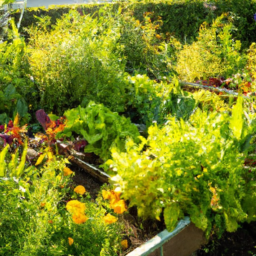Introduction
Gardens are for everyone! Even beginners can create a garden space to love and enjoy. If you're interested in starting a garden but aren't sure where to begin, raised bed gardening is a great option. In this article, we will guide you through the process of setting up and maintaining a raised bed garden, providing you with all the necessary tips and tricks for success.
Choosing the Right Location
The first step in creating a raised bed garden is selecting the right location. Your plot should be narrow enough to reach halfway across it to plant, weed, water, and harvest in the middle. A width of three to five feet is ideal, allowing for easy accessibility. Additionally, ensure that the chosen spot receives adequate sunlight for the plants to thrive.
Preparing the Soil
Once you have chosen the location, it's time to prepare the soil. Raised bed gardens are known for their excellent drainage, so it's essential to create a loose and nutrient-rich soil mix. Start by removing any existing grass or weeds from the area. Then, mix compost, peat moss, and garden soil to create a well-balanced soil mix.
Building the Raised Bed
Now that the soil is ready, it's time to build the raised bed. The most common materials for raised beds are wood, but there are also options available in metal or plastic. Make sure to choose materials that are rot-resistant and safe for growing edible plants. Measure and cut the materials according to the desired size and assemble them using screws or nails.
Filling the Bed
With the raised bed structure in place, it's time to fill it with the soil mix. Fill the bed to the top, ensuring that the soil is evenly distributed. Gently tamp down the soil to remove any air pockets and create a level surface.
Choosing Plants
Now comes the exciting part – choosing the plants for your raised bed garden. Consider the amount of sunlight your garden receives and select plants that are suitable for those conditions. Beginners may find it helpful to start with easy-to-grow vegetables such as tomatoes, lettuce, and herbs. Remember to leave enough space between plants to allow for proper growth and airflow.
Watering and Maintenance
Proper watering is crucial for the success of your raised bed garden. The soil in raised beds tends to dry out quicker than traditional garden beds, so regular watering is essential. Monitor the moisture levels and water as needed, ensuring that the soil stays consistently moist but not waterlogged.
Harvesting and Enjoying
As your plants grow and flourish, you will soon be rewarded with a bountiful harvest. Harvest your vegetables when they are ripe and enjoy the fruits of your labor. Remember to continuously monitor the plants for any signs of pests or diseases and take appropriate action if necessary.
Conclusion
Whether you're a beginner or an experienced gardener, raised bed gardening is an excellent way to create a diverse and productive garden. By following the steps outlined in this article, you'll be well on your way to a successful and enjoyable gardening experience. So, get started today and watch your raised bed garden thrive!
